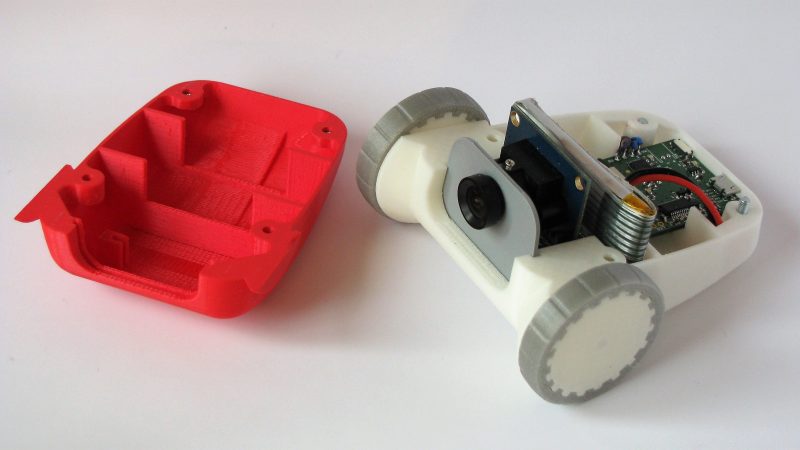When it comes to robots, it seems the trend is to make them as complicated as possible – look at anything from Boston Dynamics if you’ve any doubt of that. But there’s plenty to be said for simple robots too, such as this adorable ESP32-driven live-streaming bot.
Now it’s true that [Max.K]’s creation is more remote controlled car than robot, and comparing it to one of the nightmare-fuelling creations of Boston Dynamics is perhaps unfair. But [Max.K]’s new project is itself a simplification and reimagining of his earlier, larger “ZeroBot“. As the name implies, ZeroBot was controlled by a Raspberry Pi Zero, an obvious choice for a mobile platform designed to stream FPV video. The ESP32 bot eschews the Pi platform in favor of, well, an ESP32. To save as much space as possible, [Max.K] did a custom PCB for the microcontroller and its supporting components. The 3D-printed case is nicely designed to hold the board along with two motors, a small VGA camera, and a battery pack. At 160×120 resolution, the video isn’t amazing, but the fact that it can be streamed from the ESP32 at a decent enough framerate to drive the bot using a simple web interface is impressive.
This was a fun project and a very clean, smooth build. We like the lines of this little bot, and wouldn’t mind building one as a quick weekend project ourselves.
















Hmm, Neato now put this inside each large kid sized easily gasped chess piece and play on the floor with appropriate Ai inputs from Alexa ;-)
The one thing that is missing here is a way to easily set the SSID and password. This could be done with an app and a bluetooth or wifi direct connection.
Also a way to communicate through routers and firewalls is needed to make this useful over long distances. This could be easily done with a nodejs server on the internet that relays every message at the cost of some more lag.
It is ESP32 so why not Webmanager ?
Perhaps checkout https://hackaday.com/2019/02/02/cheap-esp32-webcam/ to try to get VGA resolution, which the camera supports. The webcam project uses a better camera, but i’d think it would work with OV7670 just aswell.
There are OV7670 versions with an on-board FIFO. Those would work for capturing a full sized image. With the FIFO-less version it will be much more difficult.
Are those home printed tires, a la https://hackaday.com/2019/01/30/3d-printed-wheels-get-some-much-needed-grip/ ? I don’t see them listed in the components list.
I believe OP mentions printing the tires from something like TPU and them slipping them on the rigid wheels. There are separate STLs for the tires and the wheels. But no harm in molding tires on like [Design/Forge] did.
Some of these camera modules have an onboard SOC that can encode into jpeg on the fly. I used to use usb webcams for streaming video over the network. The cameras were connected to the router itself which had an amazing ~200Mhz CPU and 16mb of RAM but because most of the work were done by the camera SOC itself all the router had to do is to pull the image from the SOC and send it to whatever. Could easily get 30FPS VGA.
Maybe look into a camera SOC which have onboard compression.
This is very cute! Maybe you could sell kits?